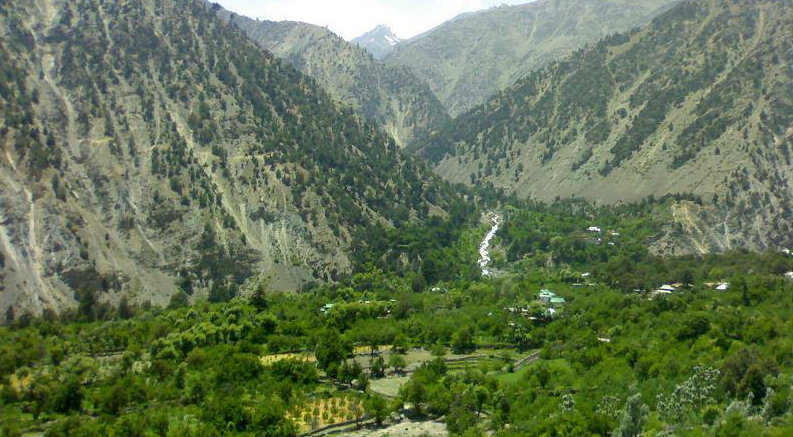Giabong Trek—Kinnaur’s Rich Bio-Diversity Reserve
Giabong is not only known for its stunning natural beauty but also for its rich bio-diversity and vibrant cultural heritage

By Colonel Satish Singh Lalotra
The Himalayas, a Natural barrier for the Indian sub-continent from the north has been a personification for all things associated & so assiduously reposed for centuries, that almost all the major religious treatises to include Mahabharata & Ramayana finds this gigantic range in all its splendor mentioned in the myriad ‘Shlokas’ that embellish these treatises. Nestled in the heart of these Himalayan ranges are countless villages, valleys, gorges, and such like geographical entities that behold an avid traveller even to this day long after they have been discovered.Mesmerizing the populace with their sheer vivacity of scenic beauty, these places are timeless in their essence. One such timeless as well priceless location that has beenacting like an enchantress to the visiting masses is nestled deep in the folds of Himalayan ranges in the kinnaur district of Himachal Pradesh.
This district of Kinnaur was earlier known as the ‘Chini’ tehsil of the former ‘Mahasu’ district that came into being as an independent district w.e.f 1st May 1960. Mahasu district later on was reorganized into Shimla & Solan districts. Prior to the merger of state on the eve of independence, Kinnaur valley was part of erstwhile ‘Rampur Bushahr’ state which had its headquarters at Rampur. Since Rampur Bushahr merged with the Indian state of Himachal Pradesh on 08 th March 1948, I thought to pen down an article as an ode to this former princely state that had Kinnaur as its part in this month of March 2025.
‘Giabong’ is the place that lies deep inside the Ropa valley astride the ‘Hindustan –Tibet road. This remote village now part of ‘Pooh’ tehsil of Kinnaur district is surrounded by majestic Himalayan peaks, verdant green environments, and picturesque valleys offering a tranquil escape from the hustle & bustle of city life. Giabong is not only known for its stunning natural beauty but also for its rich bio-diversity and vibrant cultural heritage. Another very excellent USP of Giabong’ is its famous ‘Giabong trek’ for which not much is known to the outside world except those who come to this place and partake in its rough and tumble.
Way back in October / November 1996 I had the opportunity to undertake this ‘Giabong trek’ with one of the force officers of (SFF-Special frontier force) when my unit was co-located at Giabong after having de-inducted from the Siachen glacier. The trails around Giabong offer spectacular views of the Himalayan landscape. Hiking around these trails allows a visitor to experience the regions’s natural beauty up close and personal. Located about 270 kms from Shimla, Giabong forms a part of the remote ‘Ropa valley’ and is accessible via a link road from the NH/Hindustan Tibet road that intersects the old NH road as it descends from ‘Kanam’.
Actually there are two trekking trails for Giabong, with one going as long as 31.5 kms taking about 10( ten) odd hours and a much truncated route of about 10 kms clocking about 2.5 to 3 hours. Preferring the truncated route trail, we set about the task from the point where the link road to Ropa valley starts off from the old NH/ Hindustan Tibet road and goes about the entire stretch along the Ropa stream meandering through the valley. This Ropa stream is virtually the life line to the flora and fauna of the region.
Reaching Giabong is an adventure in itself. Actually the journey for this trek starts at ‘Up MohalShyaso’ which is accessible by various modes of transportation including buses, taxis, cabs, and private vehicles. The real footslog starts from this uncanny place and goes on to become more and more taxing on the mind, bodyand spirit of a trekker. As one slogs around this truncated route one finds himself trudging along the ‘ShiasoKhad’ on which lies the picturesque ‘Ropa valley too. Since this truncated route was being frequently used by our troops for their routine morning runs ( only 2 to 3 kms), decision was taken by me to do the entire route( 10 kms) from a place which intersected the NH from a link road descending from Kanam as mentioned by me earlier.
Incidentally this entire trekking route has enchanting villages which go by the names like Syasho, Sunnam, Rukslang, Taling, Giabong and Ropa. This trekking route is prone to landslides, big rolling stones/ rocks etc which can make a new enthusiast wary in his stride. A trekker can indulge in the splendour of bio-diversity which unfolds as one moves forward toGiabong. Bird watchers and wildlife enthusiasts will find plenty of such stuff to explore, with numerous species of birds and animals inhabiting the region. The ‘Bio-diversity’ which one finds in areas like Giabong is sheer mindboggling to say the least. With flora as diverse and captivating as Kharsu, oak, weeping fig,chir pine and coniferous as well as dry broad coniferous and fauna with an equally broad spread to include snow leopards, Himalayan blue sheep, ibex, serow, western tragopan and musk deer a visitor or trekker cannot have better luck in store for him.
In fact bio-diversity includes most aspects of our lives. At the apex of this bio-diversity heap lies the quintessential human being which has a very intimate and intricate relationship with other living beings of our planet. The bio-diversity present at places like Giabong is no different as mentioned by me above. In fact due to the sheer remoteness and isolation provided by both history as well as usage , this aspect of bio-diversity angle gets more accentuated in this part of Kinnaur as compared to other places of Himachal Pradesh. Actually due to rapid urbanization that has been the norm in most parts of India, this delicate balance of bio-diversity has been shaken up to its core, with many species of both flora and fauna reeling under its adverse effects.
But then here comes to rescue the remoteness of Giabong which flaunts its rich bio-diversity heritage with equally good measure, and to the delight of a trekker who often witnesses such diversity with his own eyes. I too was not left untouched by this aspect of bio-diverse landscape of Giabong as I plodded on this trek. Another added attraction along this famed trek is the presence of the numerous apple orchards which are dotted along the Ropa valley with majority of them belonging to the famous blood red ‘Delicious’ variety. Many of them are owned by the Negi caste who have minted money by its rich harvest.
Most of the prosperous orchard owners have even installed wooden crate packaging machines wherein after having plucked the ripe apples, grade them according to their quality and pack them with the help of their local labourers. Most of them find their way to the Azadpur Mandi in Delhi from where they are shipped either overseas or even to the length & breadth of India. Many of the apples which fall due to high speed winds or even otherwise due to herbivorous bats, are separated from the hand plucked apples and sent to the HPMC collection centers at district headquarters at Reckong Peo for their conversion into apple juices or apple marmalade.
The natural beauty of Ropa valley that has this enchanting village of Giabong is truly mesmerizing to say the least. As one trudges along this Giabong trek, one encounters lush green rolling hills, and crystal clear streams. The valleys’ green bottomed oval is a sight to behold. The villages that I mentioned above which one encounters while on this trek are unique glimpse into the traditional way of life in this remote part of Himachal Pradesh. Each village has its own distinct character, charm and sights cum sounds with its terraced fields and vibrant local markets. The villagers are known for their warmth and unqualified hospitality full of life and vibrancy.
A trekker can take short breaks while going through the ups and downs of this demanding route and even come to know of the mannerisms of these locals as he or she interacts with them. The stone walled houses, rugged in design and usage shows the simplistic way of life of these villagers who are guided more by protection from the vagaries of weather prevailing in this part of HP and less on ‘style quotient’ and ‘appealing to eyes’ of an outsider. There are numerous local monasteries too all along the route adorned with colorful prayer flags fluttering in the snowy winds of this region. These monasteries are adorned with intricate carvings, and scared relics creating an overall atmosphere of peace and reverence.
Pilgrims and spiritual seekers visit these monasteries to meditate and seek blessings, thereby adding a further touch of mysterious spiritual ambience to this place. For those planning to visit this part of Kinnaur, it is essential that the best time of the year be kept at the back of the mind which is from the month of May to October when the weather is more favorable and easy on the overall health of the visitors. Whether you are a nature lover, a cultural enthusiast or a simple trekker Giabong including the Ropa valley has something for everyone. I can bet in this article of mine that though many must have gone to similar places in the remote valleys of Himalayas, but then this is one place that compresses many timelines and cultures seldom visited and explored by majority of us.
Since this Kinaaur district as brought out by me earlier was carved out from the much larger Rampur Bushahr princely state way back in March 1948, I in my wisdom was driven by the fact that some amount of pampering has to be done to this area by bringing its USP via an article from the paper of Rising Kashmir. Hence the effort, which I am sure, will be a shot in the arm of nature lovers thinking of heading this summer to Ropa valley to explore its nooks and crannies.
(Author is a retired army officer and a regular scribe of Rising Kashmir. He can be approached on his email: slalotra4729@gmail.com)




